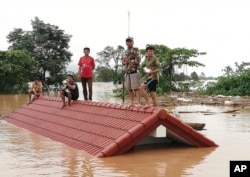At least 26 people are now confirmed dead and 103 others missing from Monday's catastrophic dam collapse in southern Laos.
The Xepian-Xe Nam Noy dam collapsed in the southeastern province of Attapeu, about 550 kilometers south of the capital, Vientiane, releasing as much as 5 billion cubic meters of water throughout the district, washing away hundreds of homes and leaving scores of residents homeless.
Witnesses told the VOA Lao Service that more 6,000 people were displaced as a result of the disaster. Many of them have been rescued and taken to government shelters in Attapeu and in nearby Champasack province.
Many of the injured have been taken to hospitals in Attapeu and other surrounding provinces.
South Korean President Moon Jae-in has ordered an emergency relief team to Laos to assist with the recovery efforts. Two South Korean firms, SK Engineering and Construction and Korea Western Power, are part of a consortium building the 410-megawatt project, along with Thailand’s Ratchaburi Electricity Generating Holding Company, and Lao Holding State Enterprise.
The Xepian-Xe Nam Noy dam was to be completed next year at an estimated cost of about $1 billion.
Just hours before the disaster Monday night, the consortium warned in a letter that millions of tons of water would surge down the Xe-Pian River if the dangerously unsafe dam failed.
In their warning letter, the consortium, known as PNPC, said the saddle dam had become unsafe because of heavy rainfall and would release 5 million tons of water into the Xe Pian River if it failed. The project reservoir is intended to rise 73 meters high by 1,600 meters long, with the capacity to store about 1,043 million cubic meters of water.
The Xe-Pian-Xe-Namnoy dams flow down into the Sekong River through Cambodia, and there are concerns of potential downstream impact.
Water levels across the Mekong region have been rising rapidly since July 15, in one case by more than 4 meters in the Laotian city of Luang Prabang, because of extremely high rainfall caused by tropical Storm Son-Ting, according to the MRC.
Harris said the incident raised concerns about the risks around dam designs unable to cope with extreme weather events exacerbated by climate change, and the adequacy of warning systems, including for dams currently under construction.
More than 70 dams are under construction or planned in Laos, including several on the Mekong mainstream. Harris said the roles and responsibilities of private companies developing these projects should be seriously questioned, in light of the disaster.
VOA Lao contributed to this article.








